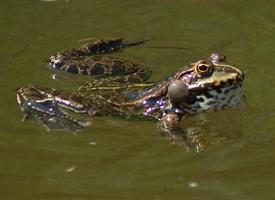
Weights and measures
| Length | 10 cm |
|---|
Animal description
The Common frog, scientifically known as Rana temporaria, is a fascinating amphibian widely distributed across Europe and parts of Asia. This species is highly adaptable and can be found in a variety of habitats, including forests, meadows, gardens, and even urban areas, provided there are suitable wetlands or ponds for breeding.Characterized by its smooth, moist skin, the Common frog exhibits a range of colors from olive green to brown, and even grey, often with distinctive dark patches or stripes. These colors can vary significantly among individuals, sometimes featuring orange or red hues, especially on their limbs and behind their eyes. This variability allows them to blend seamlessly into their surroundings, an effective camouflage against predators. The underside of the Common frog is usually lighter, ranging from white to yellow, sometimes spotted with grey or brown.
Adult Common frogs typically measure between 6 to 9 cm in length, with females generally being larger than males. They have a robust, compact body, a rounded snout, and large, bulging eyes that provide a wide field of vision, crucial for detecting predators and prey. Their powerful hind legs are well adapted for jumping and swimming, making them agile both on land and in water.
Breeding season for the Common frog occurs in early spring, when temperatures rise and ice on water bodies begins to melt. Males call to attract females, though their croak is relatively soft compared to other frog species. Females lay thousands of eggs, known as frogspawn, in shallow, still waters. These eggs are encased in a jelly-like substance that swells in water, offering protection. The development from egg to tadpole, and eventually to frog, depends on temperature and can take several months.
Tadpoles are herbivorous, feeding primarily on algae and plant matter, while adults have a carnivorous diet that includes insects, spiders, and worms. The transition from tadpole to frog involves significant morphological changes, including the development of limbs and the absorption of the tail.
The Common frog plays a crucial role in the ecosystem as both predator and prey. They help control insect populations, benefiting human agriculture and reducing the spread of diseases like malaria. In turn, they are a key food source for a variety of predators, including birds, fish, and mammals.
Despite their adaptability, Common frogs face threats from habitat destruction, pollution, and climate change, which can lead to declines in population sizes. Conservation efforts are crucial to ensure the survival of this species, highlighting the importance of protecting their natural habitats and maintaining the health of ecosystems.
In summary, the Common frog is a remarkable and adaptable amphibian with a wide distribution and significant ecological role. Its presence in diverse habitats underscores the importance of environmental conservation efforts to ensure the continued survival of this and other amphibian species.
Similar Animals
New photos of animals
Top 10 animals
- Dolphin gull (Leucophaeus scoresbii)
- Diana monkey (Cercopithecus diana)
- Moustached guenon (Cercopithecus cephus)
- Galápagos tortoise (Geochelone nigra complex)
- Japanese macaque (Macaca fuscata)
- Stone loach (Barbatula barbatula)
- Russian tortoise (Testudo horsfieldii)
- Greek tortoise (Testudo graeca)
- Common flying dragon (Draco volans)
- Vendace (Coregonus albula)


